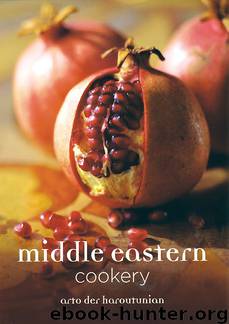Middle Eastern Cookery by Arto der Haroutunian

Author:Arto der Haroutunian
Language: eng
Format: epub, mobi
Tags: Bisac Code 1: CKB000001
ISBN: eBook ISBN| 978-1-908117-90-8
Publisher: Grub Street Cookery
Published: 2011-03-22T16:00:00+00:00
kebabs
With the discovery of fire came cooked meat, then barbecues, and kebabs. Ancient civilizations knew all about grilling meats of all kinds on fire. That was nothing new. What was new, however, was, and this came much later, the art of marination, basting and smothering the meats in herbs and spices.
Homer, in his Iliad, describes how Achilles played host to Odysseus outside the walls of Ilium.
Petroclus put down a big bench in the firelight, and laid on it the backs of a sheep and a fat goat and the chine of a great hog rich in lard. Automedon held these for him, while Achilles jointed them, and carved up the joints and spitted the slices. Meanwhile, Petroclus … made the fire blaze up. When it had burned down again and the flames disappeared, he scattered the embers and laid the spits above them, resting them on logs … When he had roasted it and heaped it up on the platters … Achilles divided the meat into portions.
In the Middle East, scenes like this are still an everyday occurrence. To celebrate a birth, wedding, anniversary or religious festival large groups of people drive to the fields or hills, prepare impromptu grills—usually in small depressions in the ground light dry branches, slaughter lambs and skin them. The innards are removed—the heart and livers are set aside as they make excellent kebabs in their own right—and the lambs are rinsed in a nearby brook. Long wooden or metal rods are pushed right through the lamb from the breast to the hindquarters and the legs are trussed. The fire is blazed and then ‘when it had burned down again and the flames disappeared’, the spits are laid above them.
Next time you have a large party try this whole lamb kebab—it will be the talk of the year!
A fascinating method—still popular in Anatolia, Caucasus, Iran and, I understand, with the Aborigines of Australasia—is to make a shallow (60–90 cm/2–3 ft) pit approximately 90 × 180 cm/3 × 6 ft in the ground and a bed of charcoal laid in the pit. The lamb is laid on the glowing charcoal and the whole is covered with earth. Five to six hours later the lamb will be cooked. It is then removed, brushed to remove the soil clinging to the skin and placed on a large tray. Two hefty people shake the tray until the meat drops from the bones. The meat is sprinkled with salt, black pepper and herbs and eaten.
In the Middle East lamb has always been the most popular meat. Indeed, to an Arab ‘meat’ simply means lamb or mutton, although in the past kid and gazelle were also eaten as well as camel’s meat which is hung from high ceilings in the semi-dark meat markets.
Cattle are seldom bred, except for buffalo—particularly in Egypt and Southern Iraq, but ‘Buffaloes are never killed for food; never, indeed, unless they are dying anyway of some disease … their lives are passed in a rich and placid leisure immune alike from fear and frustration.
Download
Middle Eastern Cookery by Arto der Haroutunian.mobi
This site does not store any files on its server. We only index and link to content provided by other sites. Please contact the content providers to delete copyright contents if any and email us, we'll remove relevant links or contents immediately.
| African | Asian |
| Canadian | Caribbean & West Indian |
| European | International |
| Latin American | Mexican |
| Middle Eastern | Native American |
| U.S. Regional |
Biscuits: A Savor the South Cookbook by Belinda Ellis(4290)
The French Women Don't Get Fat Cookbook by Mireille Guiliano(3606)
A Jewish Baker's Pastry Secrets: Recipes from a New York Baking Legend for Strudel, Stollen, Danishes, Puff Pastry, and More by George Greenstein(3545)
Better Homes and Gardens New Cookbook by Better Homes & Gardens(3525)
Ottolenghi Simple by Yotam Ottolenghi(3517)
Al Roker's Hassle-Free Holiday Cookbook by Al Roker(3499)
Trullo by Tim Siadatan(3380)
Bake with Anna Olson by Anna Olson(3357)
Hot Thai Kitchen by Pailin Chongchitnant(3320)
Panini by Carlo Middione(3252)
Nigella Bites (Nigella Collection) by Nigella Lawson(3173)
Momofuku by David Chang(3140)
Salt, Fat, Acid, Heat: Mastering the Elements of Good Cooking by Nosrat Samin(3108)
Modern French Pastry: Innovative Techniques, Tools and Design by Cheryl Wakerhauser(3076)
Best of Jane Grigson by Jane Grigson(2947)
Classic by Mary Berry(2942)
Solo Food by Janneke Vreugdenhil(2930)
Tapas Revolution by Omar Allibhoy(2929)
Ottolenghi - The Cookbook by Yotam Ottolenghi(2871)
